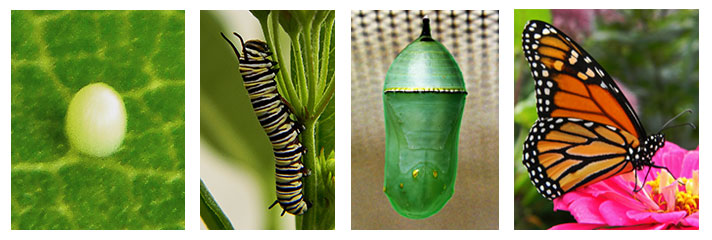
Monarchs-And-Milkweed.com
Monarch
Life Cycle
|
|
Monarchs-And-Milkweed.com |
![]()
![]()
![]()
| The Monarch Life Cycle
(technically called metamorphosis)
is the series of developmental stages that butterflies and moths go through to become adults.
Butterflies and moths have four stages of life: egg, larva (the caterpillar
stage), pupa (the chrysalis phase in a butterfly's development), and adult. It takes a
Monarch butterfly just
28 to 32 days to complete its life cycle. Light, temperature, and humidity
all play an important role in determining how long it will take a Monarch
to complete its life cycle. Warmer temperatures (so long as it's not too
warm), higher humidity (so long as it's not too humid), and extra light (so
long as it's not too much light) generally aid in faster development. Developing Monarchs usually prefer a temp of 70 to 80 degrees, humidity of 60% to 70%, and normal summer daylight/night patterns. |
![]()
 |
Monarch
females lay their eggs on milkweed, the only plant monarch caterpillars
can eat. The eggs are laid singly and generally on the undersides of leaves. The
eggs are very small (about the size of the periods at the end of the
sentences on this page) and are white in color. Each egg is attached to
the leaf by an adhesive fluid that is applied to the egg as it is being
laid. A day or two before the egg hatches, it turns gray in color. This is because you are actually seeing the tiny dark colored caterpillar inside the egg shell. Four to six days after the eggs are deposited, they should hatch. |
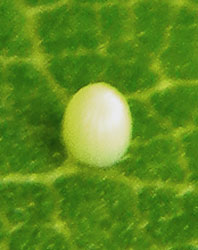 |
![]()
 |
Immediately
after hatching, the caterpillar is so small it can barely be seen. Before taking
its first bite of milkweed, a Monarch caterpillar will usually consume its
egg shell. A caterpillar has poor eyesight, being able to distinguish
little more than day from night. It has eight pair of legs (three pair of true legs on its thorax and five pair of prolegs on its abdomen) and a mouth it can use to bite off and chew its food. Just 10 to 14 days after it hatches, the Monarch caterpillar is fully grown, about 2- 3/8" long. |
 |
![]()
 |
A monarch caterpillar molts (sheds its skin) five times during the larval stage. Similar to the way a snake sheds its skin when its body has outgrown the skin, a caterpillar does the same. A new, larger skin is always waiting under the one that is shed. The period of time between molting is called the instar. |
![]()
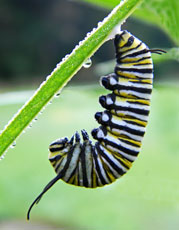 |
When the caterpillar is fully grown it usually
leaves the milkweed plant, sometimes crawling 20 or 30 feet away from the
milkweed, until it finds a safe place to pupate. The caterpillar lays down a
silk-like mat and then attaches itself to the mat with its cremaster (a
hook-like apparatus located on the tail end of the caterpillar). The
caterpillar allows itself to drop and then it hangs there, upside down in a
J-shape, for about
one full day. Just before the caterpillar pupates (shedding its skin for the fifth time), it's tentacles look wrinkled and crinkled (like they do in the photo to the right). |
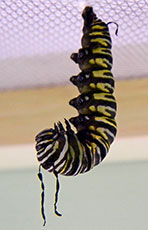 |
![]()
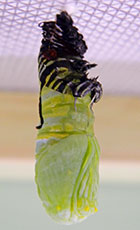 |
The caterpillar's skin is shed for the last time as it passes from the larval
(caterpillar) stage to the pupa stage of metamorphosis. Under the
caterpillar's skin this time is a jade green casing which is called a chrysalis.
Inside the chrysalis, which is only about an inch long, the caterpillar will
miraculously transform into a beautiful butterfly. Inside the chrysalis, the Monarch's mouth parts are reconstructed so that the emerging butterfly will have no chewing mouthparts but, instead, a proboscis (a retractable straw-like apparatus which will be used to sip nectar). Never again will it eat solid foods. The somewhat creepy, crawling creature transforms to become a beautiful flying insect. The emerging butterfly will have 3 pair of legs, not eight like it had as a caterpillar. It's eyesight will dramatically improve from what it was when it was a caterpillar, and its eyes will be quite large. Reproductive organs will form (they were absent in the larval stage). And all of this happens in just 10 - 14 days. |
 |
![]()
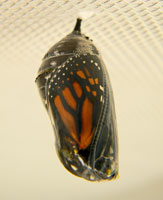 |
In just 9 to 14 days the transformation from caterpillar to butterfly is complete. Through the chrysalis, the day before the adult emerges, you can see the orange and black wings of the Monarch butterfly inside. |
![]()
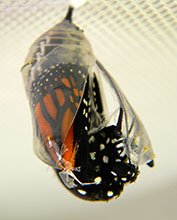 |
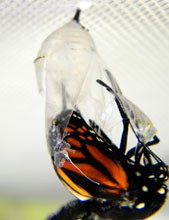 |
 |
With no visible signs to signal the emergence of the butterfly from its chrysalis, the chrysalis suddenly cracks open and out comes the Monarch butterfly. Its wings are tiny, crumpled, and wet. The butterfly clings to its empty chrysalis shell as hemolymph, the blood-like substance of insects, is pumped through its body. As the hemolymph fills the Monarch's body and wings, they enlarge. Right now, this Monarch is extremely vulnerable to predators because it is not yet able to fly. |
![]()
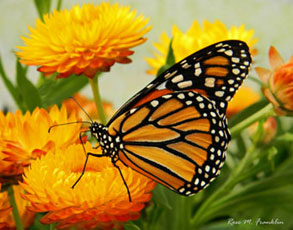 |
About an hour after emerging from its pupa (chrysalis), the Monarch's wings are full-sized, dry, and ready for flying. Here (right) a newly emerged Monarch uses it straw-like tongue, called a proboscis, to sip nectar from Strawflowers (an annual). Five to seven days after emerging from its chrysalis, a Monarch butterfly is old enough to mate.....and so begins the life cycle of of the next generation. | 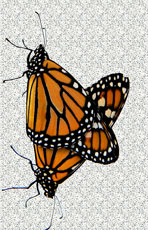 |
![]()
![]()
| Here's the answer to a few frequently asked questions: |
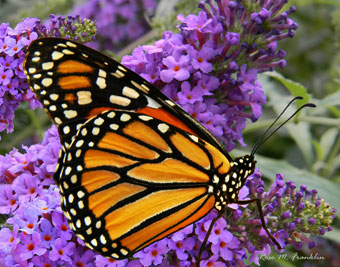 |
Once a Monarch emerges from its pupa
(chrysalis), how long does it live? Monarchs that emerge from their pupae between spring and late August only live about three weeks. The primary purpose of the adult is to reproduce. A female Monarch can lay more than 300 eggs in the couple of weeks she is alive, but most of those eggs (or the caterpillars that hatch) will be devoured by predators. More will become infected with disease and perish. Only about 2% of the eggs laid will survive long enough to produce adults. Monarchs that emerge from their pupae from late August through early October emerge with immature reproductive organs and thus, are not capable of reproducing. This generation of Monarchs will nectar, store energy in the form of fat, and then head for the mountains of central Mexico, where they will over-winter. The temperature is generally 40 to 50 degrees in these mountains, so the Monarchs are at rest most of the time as it is too cold for them to fly. Late February thru mid March, when milkweeds are beginning to grow in Texas, and the fir forests of Mexico are warming up for spring, the Monarchs will mate and the females will fly to Texas, where they will lay eggs and then expire. It will be their offspring that continue the journey northward. |
![]()
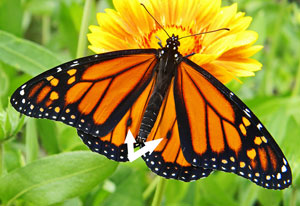 |
How can I distinguish between a male and a
female Monarch? It's actually quite easy to distinguish between the two sexes in a Monarch. The male has two black-colored oval markings on his hind wing which the female does not have (the photo to the left points to the ovals). These are actually scent patches and the scent patches release pheromones which will aid female Monarchs in locating him. Remember, the adults only live about 3 weeks and must produce offspring so the survival of the species won't be threatened. If you look at the abdomens of Monarchs, you'll see a difference too. The male has claspers at the tip of his abdomen so he can hold on to the female during mating. The female has an opening (like a slit) where the male will attach and insert sperm. |
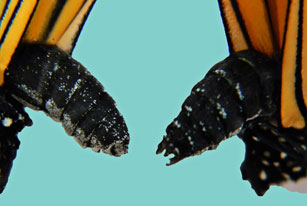 |
![]()
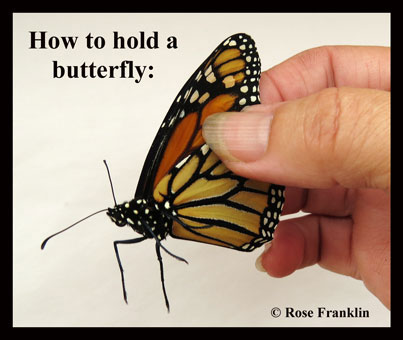 |
Is it OK to hold a Monarch? Won't they then
be unable to fly? A lot of people where taught in school that you should never, ever touch a butterfly. Doing so could make it unable to fly, or the butterfly might die if you held it. This is not true. Monarchs, and other butterflies too, have wings that are coated with tiny scales. Under a microscope, these scales resemble fish scales. They overlap like shingles on a roof. In touching a butterfly, you will remove some of their scales, but they will still be able to fly and they certainly will not die Here's a photo of how you should hold a butterfly so you won't hurt it.. Even in nature, Monarchs loose some of their scales, lots of them, just by rubbing against plants and other objects that their wings come in contact with. But butterflies are not toys and should not be handled and played with like they are toys. |
![]()
|
|
![]()
|
Rose Franklin's
Perennials (814)
422-8968
Email: MilkweedLady@aol.com |
Copyright © 2002-2024. [Rose Franklin's Perennials]. All rights reserved.
Revised: February 16, 2024